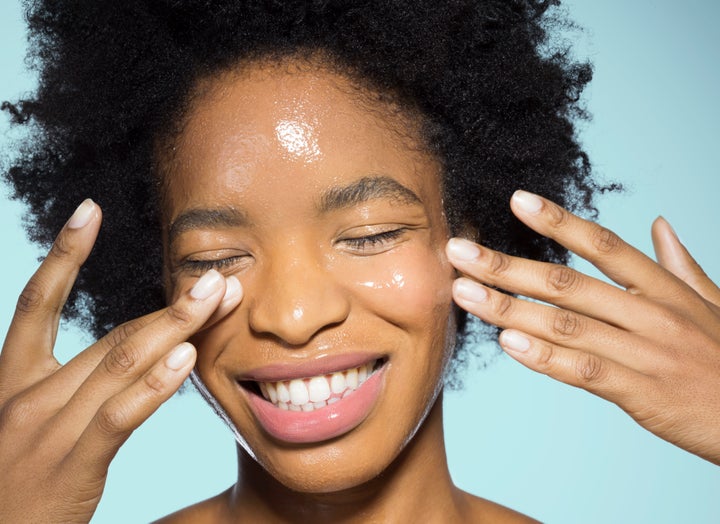
If niacinamide were a person, it would already have earned a Nobel Peace Prize. As a skin care ingredient, it can go pretty much everywhere, calm things down right away and get everything working well together. But until they start awarding global honours for skin creams (and really, why not?), mighty niacinamide continues to prove there’s little it can’t do for beleaguered, stressed and irritated skin.
What It Is And How It Helps Skin
Niacinamide is a form of vitamin B3, a water-soluble vitamin that’s a powerful antioxidant everyone needs to support a number of cellular processes. “It’s not produced naturally by the body, so you must use skin care products specifically formulated with niacinamide to experience the ingredient’s benefits,” Tom Allison, senior vice president and global head of professional marketing at CeraVe, told HuffPost.
It appears in products intended to alleviate fine lines and wrinkles, acne, eczema, discolouration, rosacea, large pores, oily skin and sun damage, among other things. If that seems like a tall order for one ingredient to address all those issues, niacinamide is up to the job, experts say.
Erin Greer, executive director of education and training at Alastin Skincare, explained that one of the ingredient’s superpowers is restoring the moisture barrier function of the skin. “As we get older, we can lose the lipid barrier that makes skin radiant and luminous. Niacinamide produces ceramides that help to restore that barrier, reduce dehydration and help skin look better.”
In a sign of our overstressed times, dermatologist Dhaval Bhanusali said, “In general, there’s a trend toward ‘calming’ ingredients. Niacinamide is a popular option since it’s so well-tolerated. It’s truly a star ingredient and one I recommend often.”
Good For Dry Skin, Oily Skin — Pretty Much Good For Skin In General
You knew we couldn’t get this far into a skin care article without talking about free radicals, those pesky molecules with unpaired electrons that can build up and cause oxidative stress, which harms other cells and speeds up aging symptoms like wrinkles. “As a true multitasker, niacinamide neutralizes free radicals and helps to address the slowing of skin aging through repair and rejuvenation,” dermatologist Melissa Kanchanapoomi Levin said. But wait, she said, there’s more: “Because it’s also been shown to regulate oil secretion and cell skin turnover, it’s recommended for both dry, sensitive skin and oily, acne-prone skin types, too.”
It might be hard to find a skin care ingredient that plays so well with others. “Niacinamide tends to complement and work well when layered with several other active ingredients that compose a typical skin care regimen,” said dermatologist Janiene Luke, co-chair of the Skin of Color Society technology and media committee and associate professor and director of the dermatology residency program at Loma Linda University. “It typically can be used in people who also use retinoids, salicylic acid and other chemical exfoliants, as well as hydrating ingredients such as hyaluronic acid.”
How To Get Started And When You’ll See Results
“Most people can tolerate niacinamide, but I’d suggest looking for concentrations that range from 2% to 10%, since higher concentrations sometimes can cause irritation,” Luke said.
“With my patients, I’ve seen them do well with up to 6% niacinamide,” Bhanusali said. “If it’s higher than that, you should spot treat first and make sure you tolerate well before applying all over.”
If you like the results you’re seeing on your face, try using it all over your body, Deanne Mraz Robinson, dermatologist and assistant clinical professor of dermatology at Yale New Haven Hospital, told HuffPost. “Look for it as an ingredient in body lotion, as well. It’s a helpful ingredient for dry, itchy skin.” She did note some caveats: “It shouldn’t be used simultaneously with skin care products that contain vitamin C. When combined with vitamin C, it turns into niacin, which can cause redness and irritation in sensitive skin.”
Once you begin regular applications, you’ll need to be patient. “Niacinamide typically takes eight to 12 weeks to work if you’re using it regularly,” dermatologist Ellen Marmur said. “But in some cases, you will see almost immediate improvement.”
And, as always, use common sense: avoid it if you’re allergic to it, of course. And go slowly. “Some people do get irritated by higher concentrations of niacinamide, so you can get too much of a good thing,” said Michelle Wong, the chemistry Ph.D. behind the Lab Muffin Beauty Science blog.